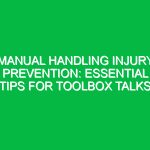Introduction
Good morning, team! Today, we’re gathering for a toolbox talk focused on an essential aspect of our operations: Material Recovery Facilities General Safety. As we dive into our work, it’s crucial to prioritize Safety and ensure that we’re all aware of the Best Practices to maintain a secure and efficient workplace. Our discussions today will help us understand the potential Hazards we face and how we can mitigate them to protect ourselves and our colleagues.
Understanding Material Recovery Facilities
Material Recovery Facilities (MRFs) play a critical role in the recycling process. They are designed to sort, process, and prepare recyclable materials for reuse. While MRFs are beneficial for the Environment, they also present unique safety challenges. Understanding these challenges is the first step in ensuring Material Recovery Facilities General Safety.
Common Hazards in MRFs
Before we discuss safety tips, let’s identify some of the common hazards you might encounter in a Material Recovery Facility:
- Heavy Machinery: Forklifts, balers, and conveyor belts are essential for operations but can pose risks if not operated correctly.
- Slips, Trips, and Falls: Wet floors, cluttered walkways, and uneven surfaces can lead to accidents.
- Hazardous Materials: Encountering chemicals or sharp objects in the recycling stream can pose health risks.
- Noise: Prolonged exposure to high levels of noise from machinery can lead to hearing loss.
- Ergonomic Hazards: Repetitive tasks or heavy lifting can cause musculoskeletal disorders.
Importance of Material Recovery Facilities General Safety
Understanding and practicing Material Recovery Facilities General Safety is vital for several reasons:
- Prevention of Accidents: By adhering to safety protocols, we can significantly reduce the risk of accidents and injuries.
- Compliance with Regulations: Following Safety Guidelines ensures we comply with local and federal regulations, protecting our facility from legal repercussions.
- Promoting a Safety Culture: Prioritizing safety fosters a culture of care and responsibility among team members.
Key Safety Practices to Implement
Now that we’ve identified the hazards and the importance of safety, let’s discuss some key practices you should implement in your daily operations:
1. Personal Protective Equipment (PPE)
Wearing the appropriate PPE is non-negotiable in ensuring your safety. This includes:
- Safety Glasses: Protect your eyes from flying debris and hazardous materials.
- Hard Hats: Safeguard your head against potential falling objects.
- Gloves: Use cut-resistant gloves when handling sharp items.
- Steel-Toed Boots: Protect your feet from heavy objects and provide better traction.
- Hearing Protection: Wear earplugs or earmuffs to safeguard against noise-induced hearing loss.
2. Safe Machine Operation
When operating machinery, always follow these guidelines:
- Receive Training: Ensure you have proper training before using any equipment.
- Conduct Pre-Operational Checks: Inspect machinery before use for any potential issues.
- Follow Operating Procedures: Always adhere to established operating procedures and safety protocols.
- Report Issues: If you notice any malfunction or safety concern, report it immediately.
3. Good Housekeeping
Maintaining a clean and organized workspace is crucial for preventing accidents:
- Clear Walkways: Ensure that all pathways are free of clutter and debris.
- Proper Storage: Store materials and tools in designated areas to avoid accidents.
- Clean Spills Immediately: Address spills right away to prevent slips and falls.
4. Communication and Teamwork
Effective communication can prevent many accidents. Here’s how to improve communication:
- Use Hand Signals: Establish and use hand signals when working in noisy environments.
- Conduct Regular Safety Meetings: Engage in daily or weekly safety meetings to discuss any concerns or updates.
- Encourage Reporting: Foster an environment where team members feel comfortable reporting safety issues without fear of reprisal.
5. Emergency Preparedness
Being prepared for emergencies can save lives. Here are steps to take:
- Know Emergency Procedures: Familiarize yourself with the emergency response plan for the facility.
- Participate in Drills: Engage in regular emergency drills to ensure everyone knows their roles.
- Have Access to First Aid: Ensure first aid kits are readily available and stocked at all times.
Real-Life Scenarios and Lessons Learned
Let’s consider a couple of real-life scenarios that illustrate the importance of Material Recovery Facilities General Safety:
Scenario 1: Machinery Malfunction
Last year, a colleague was injured when a conveyor belt malfunctioned. The operator had not conducted proper pre-operational checks, leading to a jam that caused the machine to suddenly stop, injuring the operator’s hand. This incident highlights the necessity of thorough machinery checks and adhering to safe operating procedures.
Scenario 2: Slip and Fall Incident
In another instance, an employee slipped on a wet floor that had not been marked properly. This accident could have been prevented with better housekeeping and prompt clean-up procedures. Ensuring that spills are dealt with swiftly and that wet floor signs are used can save us from serious injuries.
Regulations and Standards
Understanding the regulations that govern Material Recovery Facilities General Safety is essential. The Occupational Safety and Health Administration (OSHA) sets the standards for Workplace Safety. Familiarizing yourself with these regulations not only keeps you safe but also protects our facility from potential legal issues.
- osha Standards: Adhere to the OSHA standards relevant to waste management and recycling.
- Company Policies: Follow company-specific safety policies that align with federal and state regulations.
Conclusion
As we wrap up this toolbox talk, let’s remember that the safety of our workplace depends on each of us. By implementing the practices we discussed today, we can create a safer environment for ourselves and our colleagues. Always be proactive about your safety and the safety of those around you.
Thank you for your attention and commitment to Material Recovery Facilities General Safety. Let’s work together to make safety our top priority! If you have any questions or concerns, please feel free to share them now.


